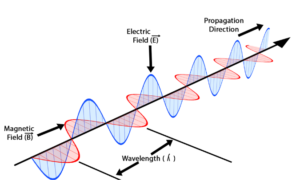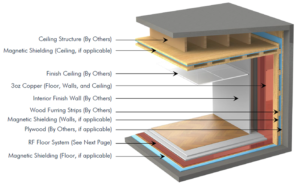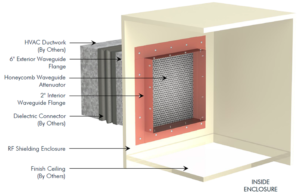Previous posts that I have written have mostly dealt with shielding gamma and neutron radiation, however there are other forms of  radiation that should be shielded in certain situation. Radio Frequency (RF) waves are a form of electromagnetic waves produced by electronic devices and networks such as cell phones or radio towers. These waves can cause interference with other sensitive electronic devices. RF and electromagnetic waves can be shielded by enclosing an area with conductive material and electronically grounding the shield. This is also commonly known as a Faraday Cage. The effectiveness of the shield will depend on the material used, thickness of the material, and what frequency the waves that need to shield are.
radiation that should be shielded in certain situation. Radio Frequency (RF) waves are a form of electromagnetic waves produced by electronic devices and networks such as cell phones or radio towers. These waves can cause interference with other sensitive electronic devices. RF and electromagnetic waves can be shielded by enclosing an area with conductive material and electronically grounding the shield. This is also commonly known as a Faraday Cage. The effectiveness of the shield will depend on the material used, thickness of the material, and what frequency the waves that need to shield are.
Uses for RF Shielding
The most common uses of RF Shielding in the medical industry is for Magnetic Resonance Imaging (MRI). MRI is a non-invasive way to take a 3D images of a person for diagnostic purposes. The MRI creates a strong magnetic field that aligns protons in the body and then detects the release of energy as the protons return to an equilibrium state creating an image of inside the body.
Rooms are shielded from RF waves for two reasons. First, in order to achieve the clearest possible image from the MRI, there needs to be minimal amounts of background RF waves. The second reason is because the MRI uses a powerful electromagnet (usually 0.5 to 2.0 Teslas in strength) which produces RF waves that will cause interference with other electronics in the surrounding area which can be very detrimental in a healthcare setting. The shielding prevents RF waves from leaving the imaging room as well as blocking out background RF waves.
Materials and Methods of Shielding
Copper is one of the most common metals used for RF shielding it has good conductivity. The copper sheets are attached to plywood  and used to line the walls, floors and ceilings. The joints are then soldered together to create a conductive shield. Another method that would be more cost effective is to use galvanized sheet steel bonded to a wood material core. The panels are then attached with steel framing joints. The downside of this method is that is difficult to install in areas with restricted site access.
and used to line the walls, floors and ceilings. The joints are then soldered together to create a conductive shield. Another method that would be more cost effective is to use galvanized sheet steel bonded to a wood material core. The panels are then attached with steel framing joints. The downside of this method is that is difficult to install in areas with restricted site access.
 A room, however, typically has more than just walls. Doors are specially designed to maintain a conductive seal when the door is shut, and windows need to be made with glass with a thin double layer metal mesh. This affects the clarity through the window but still maintains the RF shield. Finally, different utilities need to have access to the room, like electricity, HVAC and pipes for gas and water. Electrical wiring that is needed in the room must pass through a power filter which is attached to the common ground of the room.
A room, however, typically has more than just walls. Doors are specially designed to maintain a conductive seal when the door is shut, and windows need to be made with glass with a thin double layer metal mesh. This affects the clarity through the window but still maintains the RF shield. Finally, different utilities need to have access to the room, like electricity, HVAC and pipes for gas and water. Electrical wiring that is needed in the room must pass through a power filter which is attached to the common ground of the room.
Testing the Quality of the Room
Once the RF Shielding is installed, then it needs to be tested to ensure that minimal amount of RF noise in the environment surrounding the MRI equipment. Typically, to test for RF noise, a transmitter is placed outside the room that will transmit a certain frequency and strength of RF wave. A receiver is placed within the shielded room to determine how much of the signal penetrates the RF shielding. From testing it can be determined if the joints or shielding need to be replaced, or if the door’s conductive shield needs to be revaluated.
RF Shielding is important when installing an MRI machine to achieve optimal images and to reduce interferences with electronic equipment outside the room.
MarShield MRI/RF Systems
MarShield offers a variety of MRI/RF Shielding systems:
- RF Copper System
This non-ferrous enclosure is ideal for shielding applications with restricted site access. - RF Galvanized Panel System
This modular structure is traditionally used for high performance shielding that performs beyond the attenuation levels required for all major OEM’s. - Auto-Latch RF Door
Provides security and access control for RF environments. - Sliding RF Door
Fully automatic Sliding RF Door features a completely pneumatic operating system and stainless steel design ideal for multiple bay operating suites. - RF Shielded Window
Factory fabricated double layer, free of moiré pattern, non-reflective black coating with shielding equivalent to the enclosure. - RF Waveguide Air Vents
HVAC access points into the RF shielded enclosure treated with a hex cell honeycomb waveguide vent assembly.
For additional information about RF waves and the appropriate shielding, please contact MarShield. We will assist you in selecting the radiation shielding solution that best meets your requirements.
MarShield Custom Radiation Shielding Products provides radiation shielding solutions for the Medical and Nuclear Industries and is a division of Mars Metal Company. Contact us today to discuss your unique radiation shielding needs!
You might also like:
MarShield Medical – Consultation Services
Borated Polyethylene – How It Works



